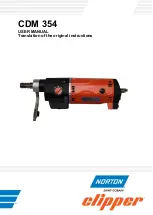
8
•
The copper piping can terminate in a “bayonet point” on a wall
or other structure. A special hose and terminator allows the
barbecue to be connected and disconnected from the bayonet
point safely and conveniently. This allows the barbecue to be
moved if necessary.
PORTABLE ULPG CYLINDER
The most flexible arrangement is a portable ULPG gas cylinder
attached by a special hose and regulator to your barbecue.
Although the cylinder needs to be refilled or exchanged when
empty, this installation has the advantage of being more mobile, and
not requiring the services of a licensed gas fitter.
BUILT IN
Whatever gas option you choose, your barbecue can be
permanently built-in.
GENERAL REQUIREMENTS
We recommend that this installation be done in a masonry
structure and carried out by a professional tradesperson. Other
non-combustible material such as Hardiplank, Villaboard with
metal studs may also be used.
The installer must test the
appliance and instruct the user regarding the operation of
the appliance.
This appliance must not be installed under or on any combustible
material. Minimum clearance from
combustible construction materials to all sides of the appliance is
450mm (18”).
Warning: Contact your local municipality for any building codes
regulating the installation of outdoor barbecue
appliances. Outdoor installations must conform to local codes or, in
the absence of local codes, with:
•
AUST: Australian Standards Code AS/NZS 5601
as well as the requirements of any local council, gas, electricity
authority or other statutory regulation.
THE BARBECUE CAVITY
Your barbecue has been designed to sit into a cavity or cutout
rather than be placed directly onto a flat surface. It is important that
the dimemsions of the cavity conform exactly to those shown (pg
15). This will ensure the barbecue sits correctly in the cavity, and
that the barbecue has sufficient ventilation to operate efficiently and
safely. It also allows room for any roasting hood to open freely,
In creating the cavity, you should ensure that you have convenient
access to the gas connection point and associated hardware:
•
If the gas for your barbecue is supplied by a portable gas
bottle, you will need access to the gas connection point, the
gas hose and the gas cylinder at all times.
•
If the gas for your barbecue is supplied by a fixed piped gas
supply (either natural gas or 45kg LPG cylinders), you will need
access to the gas connection point, the piping and the shutoff
valve.
OTHER PRECAUTIONS
Do not obstruct any of the ventilation openings in the barbecue
body. Should you need to change the gas cylinder, confirm that the
cylinder is off, and that there are no sources of ignition (cigarettes,
open flame, sparks, etc.) near before proceeding. Be sure to
inspect the gas hose and ensure it is free of any twisting or tension.
The hose should hang freely with no bends, folds, or kinks, which
could obstruct free flow of gas. Apart from the connection point,
no part of the hose should touch any hot barbecue parts. Inspect
the hose before use. If the hose is damaged, it must be replaced
with a hose suitable for use with ULPG and meet the national
standards for the country of use. The length shall not exceed 1.5m.
Should minimum clearances not be adhered to severe flare up may
be experienced due to lack of airflow around the barbecue, thus
voiding manufacturer’s warranty.
GAS AND REGULATOR INFORMATION
This barbecue is designed for LP gas use only. Bottle sizes of 4.5kg
or greater are recommended for use with this barbecue. Suitable
LPG regulators must have an outlet pressure of 2.75 kPa. You must
have the proper regulator and bottle in order for the barbecue to
operate safely and efficiently. Please consult your local gas dealer
for the most suitable gas cylinders. Please note the regulator
supplied with this barbecue is of an approved type.
The manifold thread type is 5/8” x 18.
For more information on pipe sizing, please refer to AS/NZS 5601 /
AG601 for details.
The gas cylinder must always be stored or used in an upright
position.
POL regulator
and hose
FIXING THE POL GAS REGULATOR TO THE CYLINDER
Confirm all barbecue control knobs are in the off position.
Hand-tighten the regulator supplied with this barbecue to the gas
cylinder by screwing in an anti-clockwise direction.
DO NOT OVERTIGHTEN!
As the regulator is fitted with a soft nose, it should only be tightened
a further 1/4 turn after resistance is first felt.
Leak Testing
When to Test
: The BBQ gas bottle, regulator & hose assembly
should be checked for leaks, using the soapy water leak test, every
time you reconnect your regulator to the BBQ gas bottle. You
should also test after any long period of non-use, such as at the
beginning of BBQ season.
What to use
: You will need a soapy water solution to check for any
leaks. Mixing liquid hand soap with water will work fine (do not use
any other household cleaning products).
How to Test
: Put some soapy water in a spray bottle or a dish.
Turn on the gas bottle but do
not
turn on the BBQ. Next, spray
the entire valve, regulator and hose assembly with the soapy water
including where the hose connects to the BBQ. Alternatively, you
can apply the soapy water with a paint brush, basting brush.
Bubbles will form if there is a gas leak and you may also smell the
gas. If you find a leak, turn off the gas bottle immediately!

































